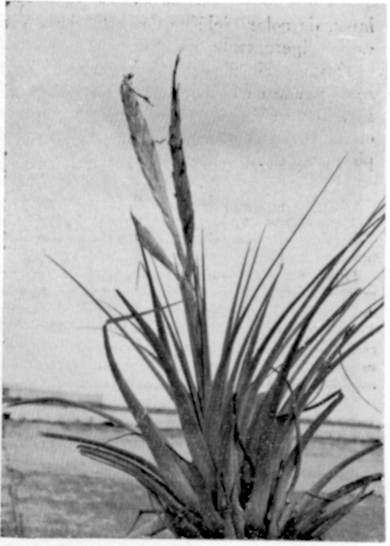
Plant stemless, flowering 50 cm high.
Leaves spreading to reflexed in a dense rosette;
Sheaths oval, 7 cm long, 4.2 cm wide, dark reddish;
Blades spreading to decurved, narrowly triangular, caudate-subulate, 40-45 cm long, 2 cm wide, very rigid.
Scape erect, stout, 15 cm long;
Scape-bracts erect, foliaceous, densely imbricate, 12-15 cm long, roseate-green, lepidote.
Inflorescence semidigitate from 2-4 spikes;
Primary bracts much shorter than the axillary spikes;
Spikes short-stipitate, linear-lanceolate, complanate, 14-20 cm long, 18-20 mm wide, glabrous, lustrous, yellow-green.
Floral bracts densely imbricate, oblong-oval, 45 mm long, 20 mm wide, carinate, coriaceous.
Sepals free, sublanceolate, 35 mm long, 4 mm wide; marcadamente acarinados (?clearly ecarinate)
Petals 48 mm long, tubular-erect, dark purple;
Stamens and style exserted.
TYPE. Rincon de la Via, Mun. Tierra Colorada, Guerrero, Mexico, 15 Aug 1973, Kruse 3088 (holotype MEXU n v).
DISTRIBUTION. Known from the type collection only.
According to the author, Tillandsia hubertiana differs from T. fasciculata Swartz in its narrowly caudate-subulate leaf-blades and narrowly lanceolate spikes. He might have added "free sepals" from his description.
T. hubertiana named after its discoverer, Mr. Hubert Kruse, was found near Rincon de la Via, Tierra Colorada, State of Guerrero. The new species resembles T. fasciculata Sw. but the leafblade is more narrowly caudate-subulate and caniculate, and the spikes are longer and narrowly lanceolate. It inhabits limestone boulders or it grows as an epiphyte on trees.
Mr. Hubert Kruse is an enthusiastic amateur botanist who has been studying the flora of that area and he has discovered many new species belonging to very different plant families.
Sue Gardner in her dissertation in 1982 suggests this is a hybrid between T. fasciculata and T. caput-medusae.